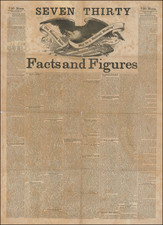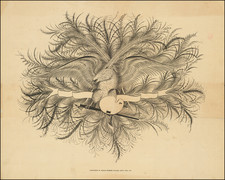Exquisitely Colored De Bry Florida Natives Print Showing Indigenous Games
An excellent example of the Iuventutis Exercitia print from Theodor de Bry's Bevis Narratio... Iuventutis Exercitia illustrates a detailed portrayal of the recreational activities of the Timucua tribe, an indigenous group from the regions of present-day northeast and north central Florida and southeastern Georgia. At the center of the composition, three Timucua men engage in archery practice archery, a skill vital for hunting and defense.
Besides the archers, two other tribe members are shown engaging in a ball game designed to train their martial abilities while also engaging in leisure. Their active poses contrast with the concentrated demeanor of the archers, shedding light on the tribe's balance between rigorous skill training and communal enjoyment.
The backdrop captures men in canoes navigating the water, a scene indicative of the tribe's connection to the region's waterways, which were being increasingly explored and mapped by Europeans at this time.
The text below the image describes the scene in the words of one European witness who discusses the ball game and other daily routines of the Timucua men.
Iuventutis Exercitia stands as a testament to de Bry's dedication to capturing the essence of indigenous life based on the accounts of European explorers, presenting a glimpse into the lives of the Timucua tribe during the late 16th century. This particular piece is vividly hand colored to further illustrate the rich lands and unique people of the New World.
https://www.nps.gov/timu/learn/historyculture/timu-society.htm
Theodor de Bry (1528-1598) was a prominent Flemish engraver and publisher best known for his engravings of the New World. Born in Liege, de Bry hailed from the portion of Flanders then controlled by Spain. The de Brys were a family of jewelers and engravers, and young Theodor was trained in those artisanal trades.
As a Lutheran, however, his life and livelihood were threatened when the Spanish Inquisition cracked down on non-Catholics. De Bry was banished and his goods seized in 1570. He fled to Strasbourg, where he studied under the Huguenot engraver Etienne Delaune. He also traveled to Antwerp, London, and Frankfurt, where he settled with his family.
In 1590, de Bry began to publish his Les Grands Voyages, which would eventually stretch to thirty volumes released by de Bry and his two sons. The volumes contained not only important engraved images of the New World, the first many had seen of the geographic novelties, but also several important maps. He also published a collection focused on India Orientalis. Les Grands Voyages was published in German, Latin, French, and English, extending de Bry’s fame and his view of the New World.










![[ Virginia Natives -- The Conjurer ] Praestigiator](https://storage.googleapis.com/raremaps/img/small/98754.jpg)
![[ Virginia Natives ] Fictilium Vasorum In Quibus Cibum Coquunt Forma XV [Their Seething of Their Meat in Earthen Pots]](https://storage.googleapis.com/raremaps/img/small/98700.jpg)

![(Nuremberg Chronicle Leaf) [Moses and the Burning Bush]](https://storage.googleapis.com/raremaps/img/small/98578.jpg)
